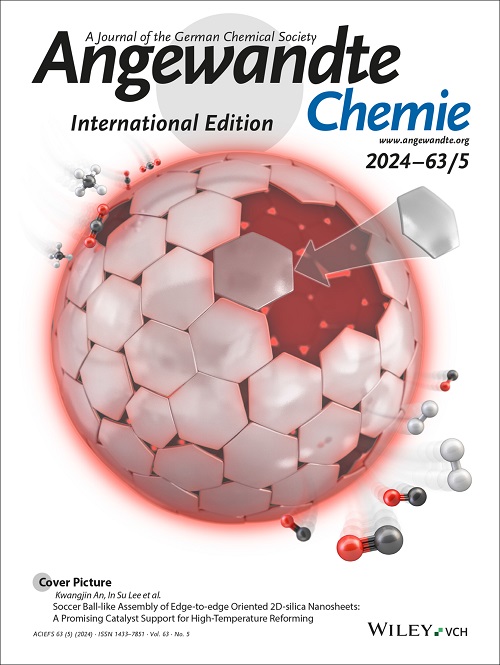Moiré Lattice of Twisted Bilayer Graphene as Template for Non-Covalent Functionalization
IF 16.1
1区 化学
Q1 CHEMISTRY, MULTIDISCIPLINARY
引用次数: 0
Abstract
We present a novel approach to achieve spatial variations in the degree of non-covalent functionalization of twisted bilayer graphene (tBLG). The tBLG with twist angles varying between ~5° and 7° was non-covalently functionalized with 1,4,5,8,9,11-hexaazatriphenylenehexacarbonitrile (HATCN) molecules. Our results show a correlation between the degree of functionalization and the twist angle of tBLG. This correlation was determined through Raman spectroscopy, where areas with larger twist angles exhibited a lower HATCN peak intensity compared to areas with smaller twist angles. We suggest that the HATCN adsorption follows the moiré pattern of tBLG by avoiding AA-stacked areas and attach predominantly to areas with a local AB-stacking order of tBLG, forming an overall ABA-stacking configuration. This is supported by density functional theory (DFT) calculations. Our work highlights the role of the moiré lattice in controlling the non-covalent functionalization of tBLG. Our approach can be generalized for designing nanoscale patterns on two-dimensional (2D) materials using moiré structures as a template. This could facilitate the fabrication of nanoscale devices with locally controlled varying chemical functionality.作为非共价功能化模板的双层石墨烯扭转莫伊尔晶格
我们提出了一种实现扭曲双层石墨烯(tBLG)非共价官能化程度空间变化的新方法。我们用 1,4,5,8,9,11-hexazatriphenylenehexacarbonitrile (HATCN) 分子对扭曲角度在 ~5° 和 7° 之间的 tBLG 进行了非共价官能化。我们的研究结果表明,官能化程度与 tBLG 扭转角之间存在相关性。这种相关性是通过拉曼光谱确定的,与扭转角较小的区域相比,扭转角较大的区域表现出较低的 HATCN 峰强度。我们认为,HATCN 的吸附遵循了 tBLG 的摩尔模式,避开了 AA 堆积区域,主要吸附在 tBLG 局部 AB 堆积顺序的区域,形成了整体的 ABA 堆积构型。这一点得到了密度泛函理论(DFT)计算的支持。我们的研究突出了摩尔晶格在控制 tBLG 非共价官能化中的作用。我们的方法可以推广到以摩尔纹结构为模板在二维(2D)材料上设计纳米级图案。这将有助于制造具有局部可控变化化学功能的纳米级器件。
本文章由计算机程序翻译,如有差异,请以英文原文为准。
求助全文
约1分钟内获得全文
求助全文
来源期刊
CiteScore
26.60
自引率
6.60%
发文量
3549
审稿时长
1.5 months
期刊介绍:
Angewandte Chemie, a journal of the German Chemical Society (GDCh), maintains a leading position among scholarly journals in general chemistry with an impressive Impact Factor of 16.6 (2022 Journal Citation Reports, Clarivate, 2023). Published weekly in a reader-friendly format, it features new articles almost every day. Established in 1887, Angewandte Chemie is a prominent chemistry journal, offering a dynamic blend of Review-type articles, Highlights, Communications, and Research Articles on a weekly basis, making it unique in the field.

 求助内容:
求助内容: 应助结果提醒方式:
应助结果提醒方式:


